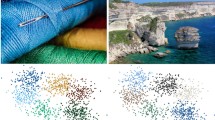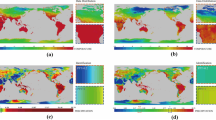Abstract
Data visualizers are usually experts in statistics and the field they involved. Most of them have lack of knowledge in arts. This leads to the condition where visualization created by them most of the time are not pleasant in terms of color, or they will be limited to the palette choices provided in the platform if they want to get a better output. This reduced the potential of visualization to act as an effective medium for marketing or awareness-raising purposes. In this paper, we study on the coding of colors in the way that is closer to human perception, together with the concept of color harmonization based on existing research. By integrating them, we get a framework that can retrieve the range of colors that looks harmony based on any request color. Our aim is to enhance the aesthetics and beauty of data visualization diagram through color modification. In the process of harmonizing the colors, our approach uses a distance scaling method on the hue dimension. This approach can better preserve the intended relationship between different colors from the original visualization. In most cases, the scaling process would be scale down, decreasing the distance between colors. Therefore, we need to take additional precautions to make sure that the scaled colors can still be perceived differently. We conducted a color difference calculation on all colors with the colors that are closest to them. Through the numerical method, we can set a minimum value and computationally identify that whether does the two colors are safe enough to distinguish. The visualization can perform an entire hue shifting process by adding a constant value to the hue of all colors after being harmonized through our approach. Our proposed approach helps data visualization artist or automated program to create a more color harmonized output, as well as providing the ability to freely change its entire color theme, which is useful to match the presenting environment, without needing to consider the problem of color difference.
Access this chapter
Tax calculation will be finalised at checkout
Purchases are for personal use only
Similar content being viewed by others
References
Burchett, K.E.: Color harmony. Color. Res. Appl. 27(1), 28–31 (2002). https://doi.org/10.1002/col.10004
Lin, S., Fortuna, J., Kulkarni, C., Stone, M., Heer, J.: Selecting semantically-resonant colors for data visualization. Comput. Graph. Forum 32(3pt4), 401–410 (2013). https://doi.org/10.1111/cgf.12127
Setlur, V., Stone, M.C.: A linguistic approach to categorical color assignment for data visualization. IEEE Trans. Visual Comput. Graph. 22(1), 698–707 (2015). https://doi.org/10.1109/TVCG.2015.2467471
Matsuda, Y.: Color design. Asakura Shoten 2(4), 10 (2002)
Cohen-Or, D., Sorkine, O., Gal, R., Leyvand, T., Xu, Y.Q.: Color harmonization. In: ACM SIGGRAPH 2006 Papers, pp. 624–630 (2006). https://doi.org/10.1145/1179352.1141933
Lara-Alvarez, C.: Reyes, T: A geometric approach to harmonic color palette design. Color Res. Appl. 44(1), 106–114 (2019). https://doi.org/10.1002/col.22292
Einakian, S., Newman, T.S.: An examination of color theories in map-based information visualization. J. Comput. Lang. 51, 143–153 (2019). https://doi.org/10.1016/j.cola.2018.12.003
Zaeimi, M., Ghoddosian, A.: Color harmony algorithm: an art-inspired metaheuristic for mathematical function optimization. Soft. Comput. 24(16), 12027–12066 (2020). https://doi.org/10.1007/s00500-019-04646-4
Cochrane, S.: The Munsell color system: a scientific compromise from the world of art. Stud. Hist. Philos. Sci. A 47, 26–41 (2014). https://doi.org/10.1016/j.shpsa.2014.03.004
Rathore, R., Leggon, Z., Lessard, L., Schloss, K.B.: Estimating color-concept associations from image statistics. IEEE Trans. Visual Comput. Graph. 26(1), 1226–1235 (2019). https://doi.org/10.1109/TVCG.2019.2934536
Olson, R.S.: Revisiting the Vaccine Visualizations. http://www.randalolson.com/2016/03/04/revisiting-the-vaccine-visualizations/ (2016)
Fairchild, M.D.: Color Appearance Models. 3rd ed. John Wiley & Sons (2013). https://doi.org/10.1002/9781118653128
Szafir, D.A.: Modeling color difference for visualization design. IEEE Trans. Visual Comput. Graph. 24(1), 392–401 (2017). https://doi.org/10.1109/TVCG.2017.2744359
Maji, S., Dingliana, J.: Perceptually optimized color selection for visualization. Tetrahedron 4(1.63299), 1–63299 (2018)
Zhang, Q., Xiao, C., Sun, H., Tang, F.: Palette-based image recoloring using color decomposition optimization. IEEE Trans. Image Process. 26(4), 1952–1964 (2017). https://doi.org/10.1109/TIP.2017.2671779
Tan, J., Echevarria, J., Gingold, Y.: Palette-based image decomposition, harmonization, and color transfer. arXiv preprint arXiv:1804.01225 (2018)
Luo, M.R., Cui, G., Rigg, B.: The development of the CIE 2000 colour-difference formula: CIEDE2000. Color. Res. Appl. 26(5), 340–350 (2001). https://doi.org/10.1002/col.1049
Yang, Y., Ming, J., Yu, N.: Color image quality assessment based on CIEDE2000. Adv. Multimedia (2012). https://doi.org/10.1155/2012/273723
Acknowledgement
The authors would like to express appreciation for the support of the Fundamental Research Grant Scheme [FRGS/1/2019/SSI07/MMU/02/1] in providing adequate resource and guidance to complete this research.
Author information
Authors and Affiliations
Editor information
Editors and Affiliations
Rights and permissions
Copyright information
© 2021 Springer Nature Switzerland AG
About this paper
Cite this paper
Lim, W.C., Wong, C.O., Wong, L.K. (2021). Color Aesthetic Enhancement for Categorical Data Visualization. In: Badioze Zaman, H., et al. Advances in Visual Informatics. IVIC 2021. Lecture Notes in Computer Science(), vol 13051. Springer, Cham. https://doi.org/10.1007/978-3-030-90235-3_2
Download citation
DOI: https://doi.org/10.1007/978-3-030-90235-3_2
Published:
Publisher Name: Springer, Cham
Print ISBN: 978-3-030-90234-6
Online ISBN: 978-3-030-90235-3
eBook Packages: Computer ScienceComputer Science (R0)




